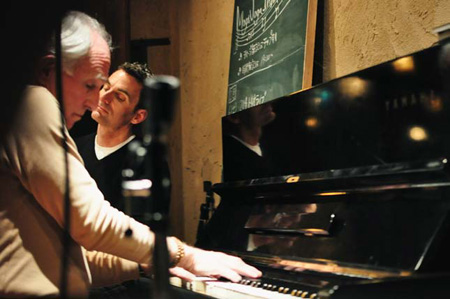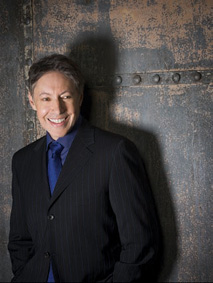Presentation Zen: Simple Ideas on Presentation Design and Delivery, 2nd Edition (Ira Katz's Library) (30 page)
Authors: Garr Reynolds

Here’s a sample of the kind of remarkable messages Ben conveys to his audiences. In this case, he is talking about musicianship, but his words can be applied to most of our presentation situations, too:
“This is the moment—this is the most important moment right now. Which is: We are about contribution. That’s what our job is. It’s not about impressing people. It’s not about getting the next job. It’s about contributing something.”
—Benjamin Zander
It’s not always about success or failure, it’s about contribution and being fully present. Rather than asking questions such as “Will I be appreciated?” or “Will I win them over?” and so on, ask “How can I make a contribution?” Here is what Ben said to a talented young musician while coaching him on his musical performance: “We are about contribution, that’s what our job is... everyone was clear you contributed passion to the people in this room. Did you do it better than the next violinist, or did he do better than a pianist? I don’t care, because in contribution, there is no better!”
The Zanders say that rather than getting bogged down in a sea of measurement—during which you compare yourself to others and worry about whether you are worthy to be making the presentation or whether someone else could be doing it better—instead realize that at this moment, right here right now, you are the gift. Your message is the contribution. There is no “better,” there is only now. It really is pretty simple.
Not every presentation situation is about contribution, perhaps, but most are. In fact, I don’t think I have ever given a presentation that was not at some level about making a contribution. Certainly, when you are asked to share your expertise with a group of people who are, on the whole, not specialists in your field, you have to think very hard about what is important (for them) and what is not (again,
for them
). It is easier just to do the same presentation you always do, but it is not about impressing people with the depths of your knowledge. It’s about sharing or teaching something of lasting value.
In most cultures—and certainly in Japan—making a mistake is the worst thing you can do. Ben Zander says it’s dangerous for musicians, for example, to be so concerned with competition and measuring themselves against others because this makes it “difficult to take the necessary risks with themselves to become great performers.” Only through mistakes can you see where you’re lacking, where you need to work. We hate mistakes, so we play it safe. Yet long term, nothing could be more dangerous if your goal is to be great at what you do. Zander suggests that instead of getting so dejected by mistakes, we instead exclaim loudly, raise our arms, and shout “How fascinating!” every time we make a mistake. Think about that. Another mistake? How fascinating! Another opportunity to learn something just presented itself. Another unlucky break? No worries! Move forward. You cannot worry about mistakes and be fully present in the moment at the same time.
It is not enough to know a piece of music intellectually or to play it without any mistakes—you have to convey the true language of the music emotionally, says Ben. When musicians truly got into the music and play it with such heart and emotion that audiences were moved beyond words, Ben noticed that the music flowed through the musicians, taking control of their bodies as they
swayed from side to side. Zander, then, urges musicians to become “one-buttock players,” that is to let the music flow through their bodies, causing them to lean and to move from one buttock to the other. If you’re a musician, or you’re making a performance of virtually any kind, and you are totally in the moment and connecting with the language of the music and the audience, there is no way you can be a “two-buttock player.” You’ve got to move, you’ve got to connect, and you must not hold back your passion. Instead, you must let the audience have a taste of the commitment, energy, and passion you have for the music (or the topic, the ideas, etc.).
You can hold back, aim not to make an error, and play it perfectly “on two buttocks.” Or, you can say, “Screw it!—I’ll take a risk,” and dare to lean into the music with intensity, color, humanity, and passion and quite possibly, in your own small way (and on only one buttock), change the world. Play it with total sincerity and with your entire body—heart and soul—and you will make a connection and change things. As Ben Zander said while encouraging one of his talented students to play it in the “one-buttock” style: “If you play that way, they won’t be able to resist you. You will be a compelling force behind which everyone will be inspired to play their best.”

Jazz pianist Dr. John Hanagan is fully in the moment while playing in a popular jazz club in Osaka, Japan. That’s me on drums and “Taku” is playing bass off camera. (Photo: Nikolas Papageorgiou.)
“Lighten up,” says Ben Zander, “and you lighten up those around you.” This is not to suggest that you shouldn’t take your work seriously (you should), or even that you shouldn’t take yourself seriously (that may depend on the time and place), but as an absolute certainty, we must all get over ourselves. There is perhaps no better way to get over ourselves than the use of humor.
Rosamund Zander, the philosopher of the partnership, says that from birth we are concerned about measurement and worried about the perceived scarcity of love, attention, food, and so on that seems to be the way of the world. She calls this the “calculating self,” and in this environment of scarcity, competition, and comparison, “the self needs to be taken very seriously indeed.” No matter how successful and confident you may become as an adult, your “calculating self” (concerned with measurement and worried about scarcity) is weak and sees itself at risk of losing everything.
The goal, then, is to move away from the calculating self, the self that lives in a world of scarcity, exaggerated threats, and deficiencies, and move toward a healthier attitude of sufficiency, wholeness, and possibilities. Getting over yourself—humor is a great vehicle for this—allows you to see the “creative nature of the world and ourselves.” When you understand what an infant can’t—that is, you cannot control the world, you cannot impose your will on people’s hearts—you begin to get over yourself.
When you learn to lighten up, you see yourself as permeable, not vulnerable, says Rosamund, and you stay open to the unknown, new influences, and new ideas. Rather than trying to resist and fight the river of life, you move through it with a harmonious fluidity and grace, learning to join rather than resist the flow. Humor is a wonderful way to remind everyone around us—no matter how hard the work gets—that our true and most “central” self is not obsessed with childish demands, entitlements, and calculations but is instead supportive, confident, helpful, and even inspiring. A presentation is as good a time as any to let people see that side of you.
• Like a conversation, presentation requires your full presence at that time and place.
• Like a master swordsman, you must be completely in the moment without thoughts of the past, the future, winning, or losing.
• Mistakes may happen, but do not dwell on past mistakes or worry about future ones. Be only in this moment, sharing and conversing with the audience in front of you.
• You will make it look easy and natural by preparing and practicing like mad. The more you rehearse, the more confident you’ll become, and the easier it will seem to the audience.
• Although you must plan well, being fully in the moment also means that you remain flexible, totally aware, and open to the possibilities as they arise.


“They’re waiting for you to show yourself to them...”
—Tom Grant
Most of what I have learned about communication and connection did not come from my speech and communication classes in school. It came from my experience as a performer and from years of closely watching others perform. I worked my way through college playing drums in various jazz groups beginning when I was 17. No matter how technically “good” the music was, I have never seen a great performance that lacked a solid connection between the performer and the audience.
Playing music is a performance and also very much a presentation. Good presentations are about conversing, sharing, and connecting on an intellectual
and
emotional level in an honest and sincere way. It is even easier to connect when playing music since everything is right out there for everyone to see and hear. It doesn’t get much more honest than jazz, which has been called “the music of dialogue.” There are no politics and no walls. The music may touch the audience or it may not, but there is never even a hint of insincerity, questionable motives, or pretense of being anything other than what people see before them at that moment. The smiles, the heads nodding in agreement, and the feet tapping under the tables tell me that there is a connection, and that connection is no less than communication. It’s a fantastic feeling.
Tom Grant, based in Portland, Oregon, is a musical legend in America’s Pacific Northwest. You can buy his albums and hear his songs on jazz and soft jazz stations around the world, including in Japan. Tom is a great musician, but what I always like about his live performances is his warmth and friendly, engaging style that just make the connection with the audience so much better.
The lesson I’ve learned from watching great live musical performances is that the music plus the artist’s ability to convey the (musical) message and connect with the audience is what it’s all about. If done well, the end result is far more than just the notes played. A true performance transcends the simple act of artists playing music and people listening. It’s bigger than that.
The art of musical performance and the art of presentation share the same essence. That is, it’s always about bridging the distance between the artist and audience to make a real connection.
If there’s no connection, there can be no conversation. This is true whether you’re pitching a new technology, explaining a new medical treatment, or playing at Carnegie Hall.
To Tom Grant, performance is not an exhibition—I perform, you listen. Tom clearly feels it’s a two-way encounter. Here’s what Tom said in an interview in
Smooth Vibes
in 2005:
“
There is joy in music for the player and for the receiver. I play music because it is my calling in life. I hope it conveys a joy and benevolence that people can apply to their own lives and thus improve, if only in the tiniest way, the quality of life on earth.”
Are not presentations about the player (presenter) and the receiver (audience)? A good tip to always remember: It’s not about us, it’s about them. And about the message.

